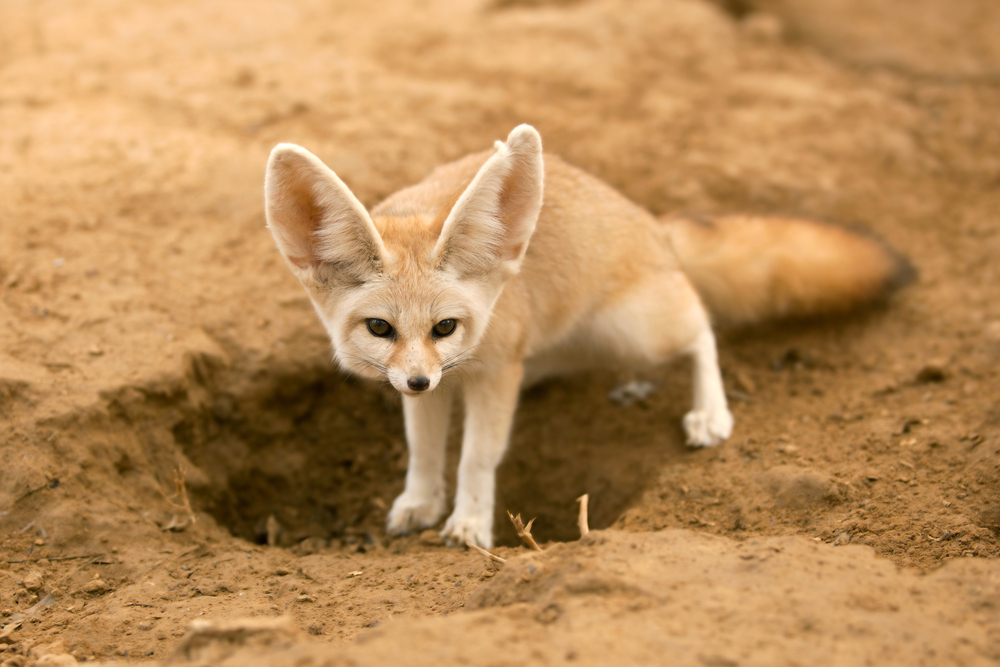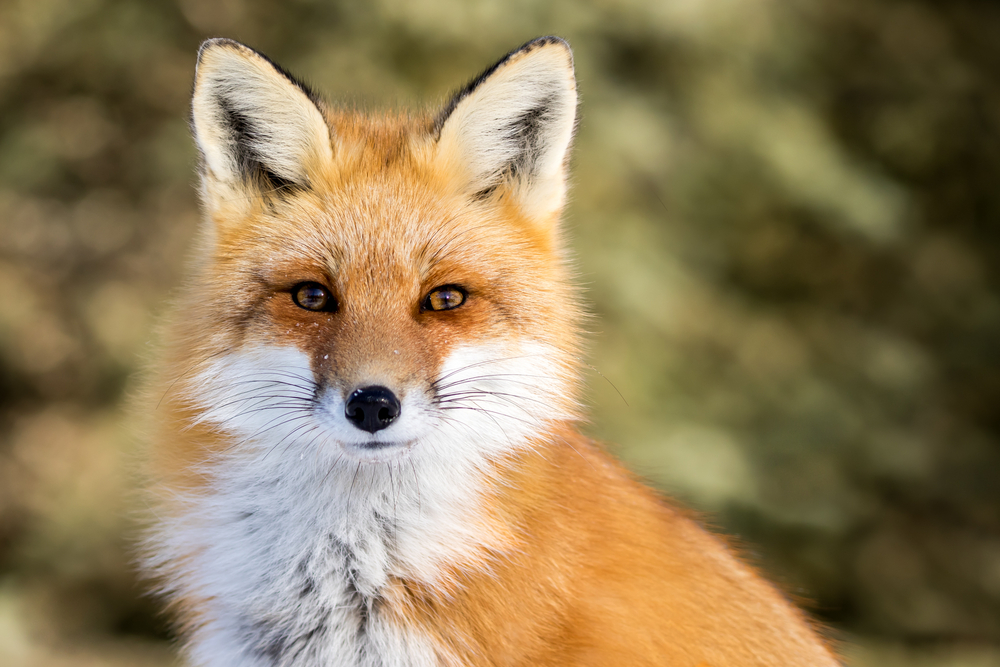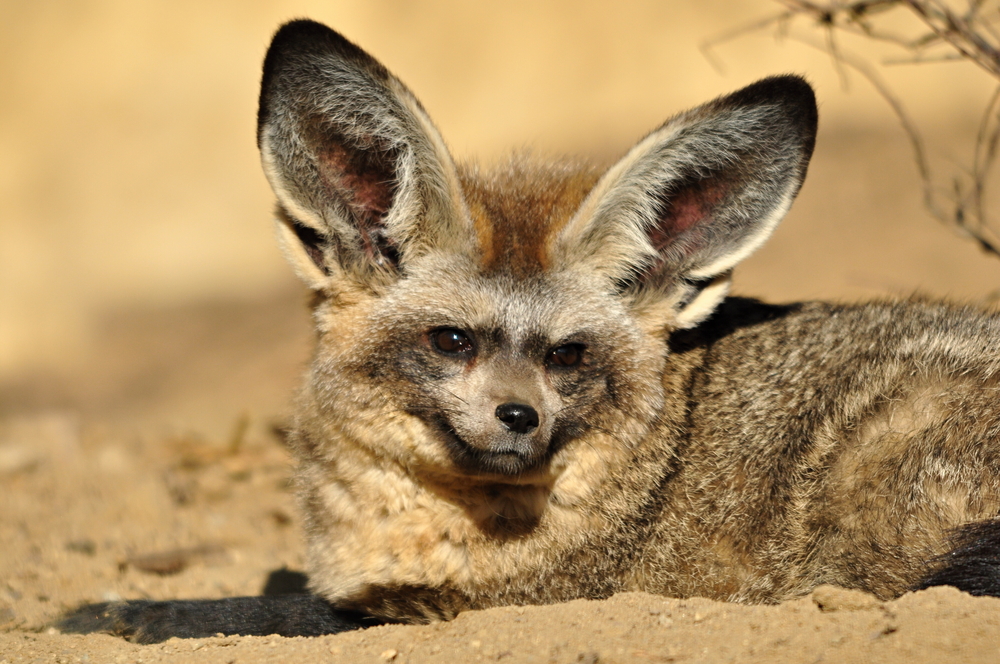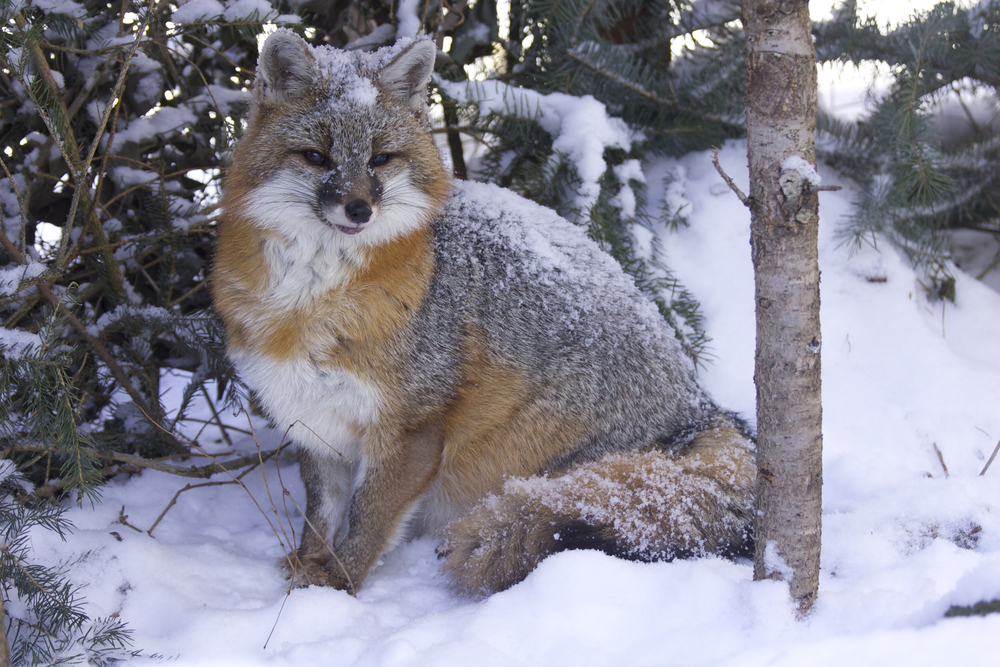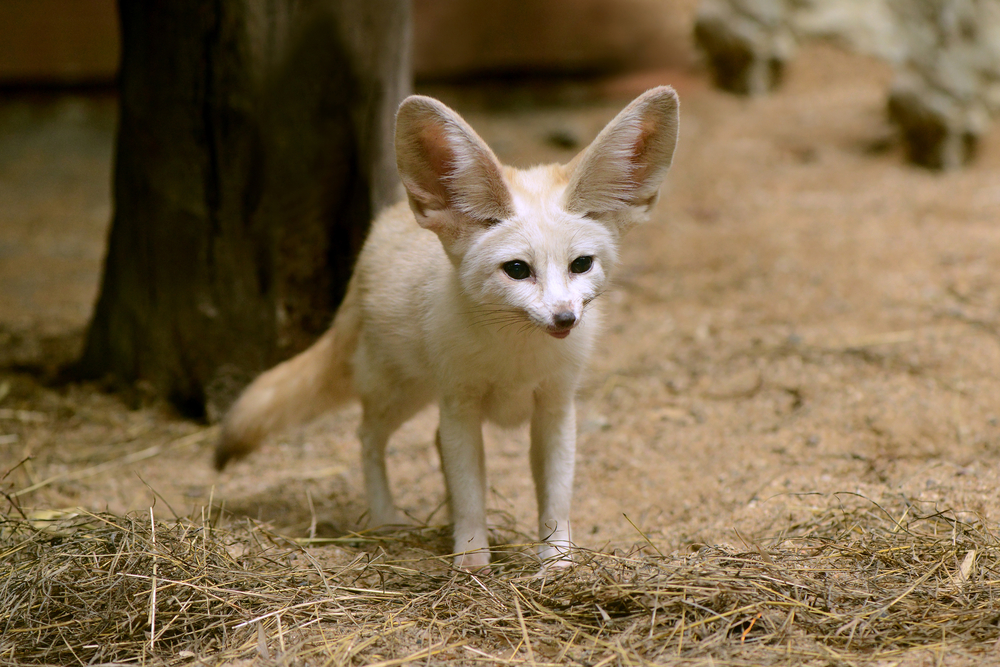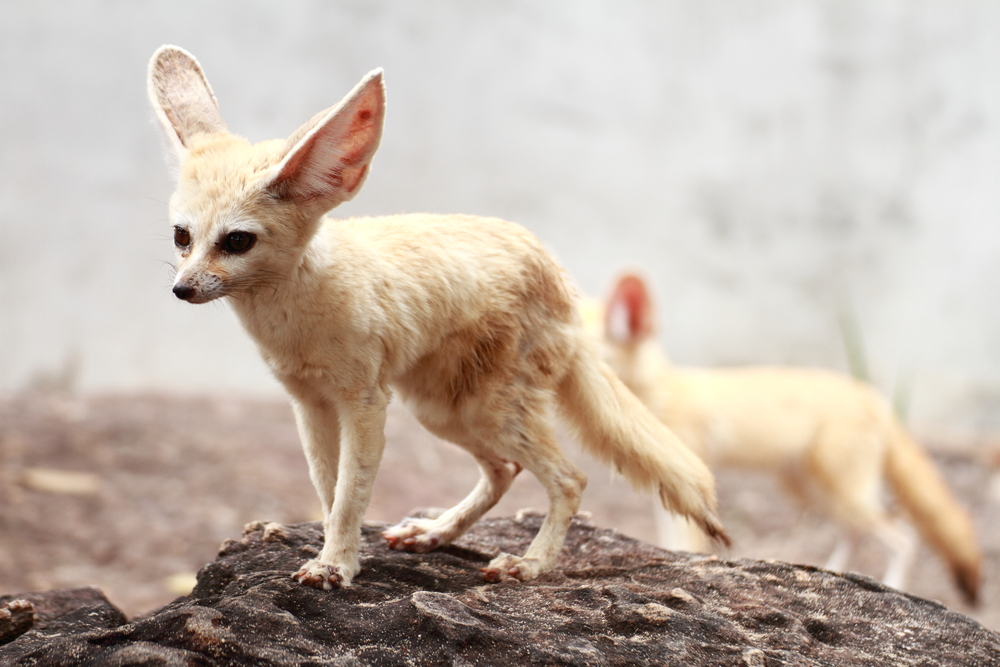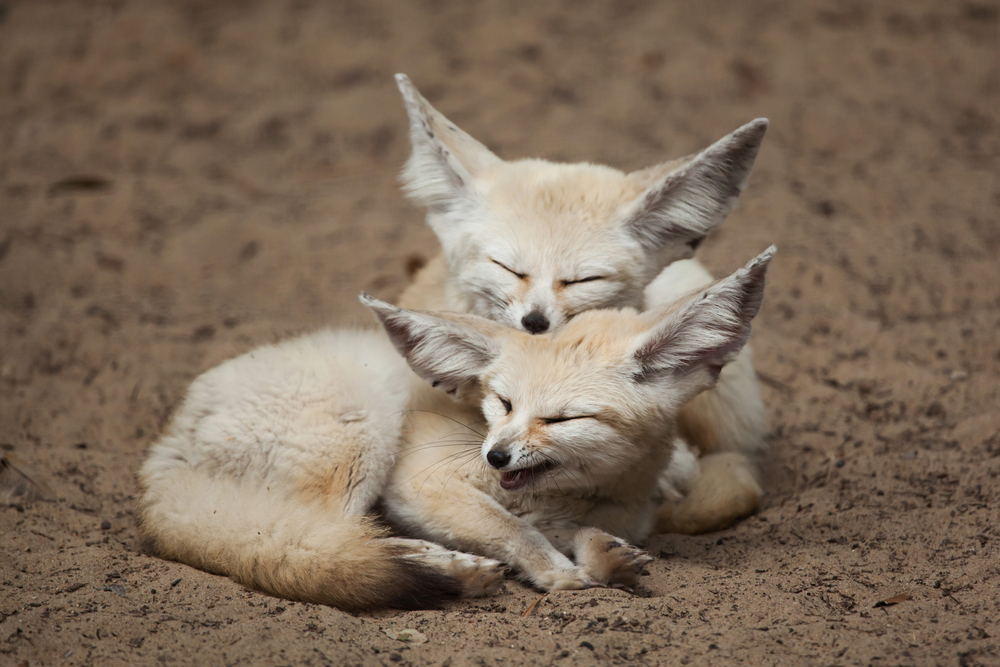About
The Fennec Fox, scientifically known as Vulpes zerda, is a small fox species belonging to the Animal Kingdom’s class Mammalia and order Carnivora. It is a member of the Canidae family, which includes other fox species such as red foxes and Arctic foxes. The Fennec Fox is native to the deserts of North Africa, particularly the Sahara Desert.
Fennec Foxes are characterized by their distinctive large ears, which serve to dissipate heat and detect prey underground. They have a sandy-colored fur coat that helps camouflage them in their desert habitat. These foxes are small in size, weighing between 1.5 to 3.5 pounds and measuring up to 16 inches in length, excluding the tail.
Primarily nocturnal, Fennec Foxes are well-adapted to desert life, hunting for insects, rodents, birds, and fruits under the cover of darkness. They are also known to dig extensive burrow systems for shelter from the extreme desert temperatures during the day.
Conservation Needs and Status
While the Fennec Fox is not currently assessed for conservation status on the International Union for Conservation of Nature (IUCN) Red List, its populations may face threats from habitat loss, degradation, and fragmentation due to human activities such as urbanization, agriculture, and development in desert regions.
Additionally, Fennec Foxes may be targeted by humans for the exotic pet trade, leading to concerns about unsustainable harvesting from the wild and potential impacts on wild populations. The pet trade can also result in welfare issues for individual animals kept in captivity.
Conservation efforts aimed at protecting Fennec Fox populations involve habitat conservation, establishing protected areas, and implementing measures to regulate the trade and ownership of exotic pets. Public education and awareness campaigns about the importance of conserving desert ecosystems and the ethical considerations of keeping exotic animals as pets are also crucial for promoting their conservation.
Physical Characteristics
The Fennec Fox (Vulpes zerda) is the smallest of the canid family but boasts the largest ears relative to body size, a feature that makes it instantly recognizable. Native to the Sahara Desert and other arid regions in North Africa, this diminutive fox has adapted beautifully to life in extreme heat, exhibiting a range of physical characteristics that aid in its survival.
Size and Weight:
- Length: From head to the base of the tail, Fennec Foxes measure approximately 9 to 16 inches (24 to 41 centimeters), with their tails adding another 7 to 12 inches (18 to 30 centimeters) to their length.
- Height: At the shoulder, they stand about 8 inches (20 centimeters) tall.
- Weight: They are lightweight, tipping the scales at just 2 to 3.5 pounds (0.9 to 1.6 kilograms).
Physical Characteristics:
- Ears: The most distinctive feature of the Fennec Fox is its oversized ears, which can be as long as 6 inches (15 centimeters). These large, heat-dissipating ears help to keep the fox cool in the desert heat and are also highly sensitive, capable of detecting prey moving underground.
- Fur: Their coat is long, soft, and thick, providing excellent insulation against the harsh desert temperatures. The fur is predominantly cream-colored, which reflects sunlight during the day and provides warmth during cold desert nights.
- Tail: The tail is fluffy and long, with a black tip. It serves multiple purposes, including balance and warmth, as the fox wraps it around itself when sleeping.
- Paws: The Fennec Fox has furry soles that protect its feet from the scorching sand. This adaptation also aids in silent movement, making it an effective hunter.
- Nose and Eyes: Its small nose reduces moisture loss, a crucial adaptation for conserving water in arid environments. The fox’s large, almond-shaped eyes are well-adapted for night vision, allowing it to avoid the daytime heat and be active during cooler nocturnal hours.
- Behavior: While not a physical trait, it’s worth noting that Fennec Foxes are highly social animals, living in groups that can number up to ten individuals. This social structure aids in their survival, providing increased vigilance against predators.
The Fennec Fox’s charming appearance belies its hardy nature and superb adaptations to one of the most extreme environments on Earth. Its ability to thrive in the Sahara’s harsh conditions is a testament to the remarkable resilience and adaptability of desert species.
Reproduction
The Fennec fox exhibits a unique reproductive cycle adapted to its arid desert habitat and social structure. Here’s an overview:
Breeding Season: Fennec foxes typically breed once a year, with the breeding season occurring during the cooler months, usually from January to March.
Courtship and Pair Formation: During the breeding season, male and female Fennec foxes engage in courtship behaviors, including vocalizations, scent marking, and mutual grooming. Pairs form strong bonds that may last beyond the breeding season.
Gestation: After successful mating, the gestation period for Fennec foxes lasts approximately 50 to 52 days.
Denning and Birth: Females excavate dens in sandy soils or use pre-existing burrows for birthing and rearing their young. They give birth to litters of typically 2 to 5 pups, although litter size can vary.
Maternal Care: Female Fennec foxes provide extensive maternal care to their pups, nursing them and keeping them warm in the den. The father may also assist in caring for the offspring by bringing food to the den.
Development and Weaning: Fennec fox pups are born blind and deaf, relying entirely on their mother for nourishment and protection. They begin to open their eyes at around 10 days old and are weaned gradually over several weeks.
Family Dynamics: Fennec fox families exhibit cooperative breeding behavior, with older siblings often assisting in caring for younger pups. This cooperative care helps ensure the survival of the entire litter.
Dispersal and Independence: As the pups grow and develop, they become more independent and eventually leave the den to explore their surroundings. They reach sexual maturity at around 9 to 11 months of age.
Environmental Factors: The reproductive cycle of Fennec foxes is influenced by environmental factors such as food availability, temperature, and precipitation patterns in their desert habitat. These factors can affect the timing of breeding and the survival of offspring.
Conservation Concerns: Habitat loss, human disturbance, and illegal pet trade pose significant threats to Fennec fox populations. Conservation efforts focus on protecting their natural habitat, enforcing regulations against illegal trade, and raising awareness about the importance of conserving this charismatic desert species.
Lifespan
The Fennec Fox, a small nocturnal fox species native to the deserts of North Africa, is known for its distinctive large ears and sandy-colored fur. Here’s an overview of their lifespan and threats to their life:
Wild Lifespan: In the wild, Fennec Foxes typically have a lifespan of around 10 to 12 years. However, their lifespan can vary depending on factors such as predation, availability of food and water, disease, and human disturbances.
Lifespan in Captivity: In captivity, Fennec Foxes may live longer than their wild counterparts due to access to consistent food, veterinary care, protection from predators, and controlled environments. Under optimal conditions, captive Fennec Foxes can live up to 14 to 15 years or more.
Threats to Fennec Foxes:
- Predation: Despite their agility and nocturnal behavior, Fennec Foxes are vulnerable to predation by larger carnivores such as jackals, eagles, and domestic dogs.
- Habitat Loss: Habitat loss and fragmentation due to human activities, including urbanization, agriculture, and development, threaten the natural habitats of Fennec Foxes. Loss of suitable habitat reduces their access to food, shelter, and breeding sites.
- Poaching and Illegal Trade: Fennec Foxes are sometimes targeted by poachers for the illegal pet trade due to their cute appearance and small size. Capture for the pet trade can lead to population declines and disrupt social structures in wild populations.
- Climate Change: Climate change-related impacts, such as extreme temperatures, droughts, and habitat degradation, can affect the availability of resources for Fennec Foxes. Changes in precipitation patterns may alter the distribution of vegetation and prey species, impacting the survival and reproduction of Fennec Fox populations.
- Disease: Like many wildlife species, Fennec Foxes are susceptible to diseases transmitted by parasites, pathogens, and other animals. Outbreaks of diseases such as rabies, distemper, and canine parvovirus can decimate Fennec Fox populations, especially in areas where they come into contact with domestic animals.
- Human Disturbance: Human activities, such as tourism, recreational activities, and vehicle traffic in desert habitats, can disturb Fennec Foxes and disrupt their normal behaviors. Disturbances can cause stress, habitat abandonment, and decreased reproductive success in Fennec Fox populations.
Conservation efforts for Fennec Foxes focus on habitat protection, anti-poaching measures, public education about the risks of keeping them as pets, and research to better understand their ecology and behavior. Protecting their natural habitats and minimizing human impacts are essential for ensuring the long-term survival of Fennec Fox populations in the wild.
Eating Habits
The Fennec Fox, native to the deserts of North Africa, possesses unique dietary adaptations suited to its arid habitat. Understanding its eating habits sheds light on its foraging strategies and nutritional needs in harsh desert environments.
Diet: Fennec foxes are opportunistic omnivores, meaning they consume a diverse range of plant and animal matter. Their diet typically consists of:
- Small Mammals and Insects: Fennec foxes primarily prey on small mammals such as rodents, birds, and insects like beetles, grasshoppers, and locusts. They rely on their keen senses of hearing and smell to detect and locate burrowing prey in the desert sands.
- Bird Eggs and Nestlings: During breeding seasons when available, fennec foxes may raid bird nests to feed on eggs and nestlings. This provides a concentrated source of nutrients and energy vital for their survival and reproduction.
- Plant Matter: While animal prey forms the bulk of their diet, fennec foxes also consume plant matter such as fruits, roots, and tubers. These plant foods supplement their diet and provide essential vitamins and minerals.
Foraging Behavior: Fennec foxes employ various foraging techniques to capture prey and gather food resources in their desert habitat:
- Hunting: Fennec foxes are skilled hunters and use a combination of stalking, pouncing, and digging to capture small mammals and insects. Their large ears help them locate the rustling sounds of prey beneath the desert sand, while their agility allows them to swiftly chase and catch elusive prey.
- Scavenging: In addition to hunting, fennec foxes scavenge carrion and food scraps left behind by other desert predators. They opportunistically feed on the remains of larger animals, maximizing food resources in their arid environment.
Water Requirements: Fennec foxes have evolved remarkable adaptations to survive in water-scarce environments. They obtain much of their water needs from their prey and can also derive moisture from juicy fruits and succulent plant parts. Additionally, fennec foxes have highly efficient kidneys that minimize water loss, allowing them to thrive in their arid habitat with limited access to free-standing water sources.
Nocturnal Feeding: Fennec foxes are primarily nocturnal, meaning they are most active during the night. Their nocturnal habits help them avoid the intense heat of the desert during the day and coincide with the activity patterns of their prey, enhancing their hunting success.
Other Considerations:
- Human activities such as habitat destruction, overgrazing, and illegal trapping pose significant threats to fennec fox populations in the wild, impacting their access to food resources and disrupting their natural foraging behaviors.
- Conservation efforts focused on preserving their desert habitat and mitigating human-induced threats are crucial for ensuring the long-term survival of fennec fox populations in their native range.
Uniqueness
The Fennec Fox, scientifically known as Vulpes zerda, is a small nocturnal fox known for its distinctive features and adaptations to the Sahara Desert and other arid regions. Here are some key aspects that make the Fennec Fox unique:
Exceptionally Large Ears: Fennec Foxes are most famous for their remarkably large ears, which can be as long as 15 centimeters (6 inches). These ears serve a dual purpose: they dissipate heat to help keep the fox cool in the hot desert environment, and they are highly sensitive, capable of detecting even the slightest sounds of insects, small rodents, or other prey.
Small Size: The Fennec Fox is the smallest of all canid species, weighing between 0.9 to 1.5 kg (2 to 3.3 lbs) and measuring about 24 to 41 cm (9 to 16 in) in length, with an additional 20 cm (8 in) for the tail. Their small size helps them navigate the desert environment with ease and remain less detectable to predators.
Thick Fur and Specialized Paws: Their body is covered in thick, long fur that protects them from the harsh desert sun during the day and keeps them warm during cold nights. The fur on their feet pads helps protect their paws from the hot sand, also aiding in stealthy movement.
Nocturnal Habits: To avoid the extreme heat of the desert day, Fennec Foxes are nocturnal. During the night, they are very active, hunting for food and socializing with other foxes.
Diet and Water Conservation: Fennec Foxes are omnivores with a diet that includes fruits, leaves, rodents, insects, and birds. They are capable of surviving without free-standing water for long periods due to their kidneys being adapted to restrict water loss, a critical adaptation in arid environments.
Burrowing Lifestyle: They live in extensive burrows or dens that can be as deep as 1 meter (3 feet) underground. This not only provides protection from predators and extreme weather but also helps regulate their temperature during the extreme heat.
Social Behavior: Unlike many other fox species, Fennec Foxes exhibit social behavior, often forming small communities linked through an intricate network of burrows. These groups consist of mating pairs and their offspring.
Reproductive Traits: Fennec Foxes are known for their reproductive efficiency in harsh environments. Females can give birth to a litter of two to five pups annually, and the communities they form help in the communal rearing and protection of the young.
Conservation Status: Currently, Fennec Foxes are not considered endangered, but they face threats from the illegal pet trade and habitat loss. Their charismatic appearance and relatively docile nature make them popular in the exotic pet market, which can lead to issues with illegal trapping and trading.
The combination of their strikingly large ears, ability to thermoregulate, social nature, and adaptations to desert life make the Fennec Fox a uniquely equipped survivor of some of the harshest habitats on earth, underscoring the remarkable diversity of evolutionary adaptations among canids.
Related Family Species
Sources
- Britannica, Fennec Fox, https://www.britannica.com/animal/fennec, retrieved December 2023
- Burnie, David & Wilson, Don, Animal, Smithsonian Institute, Washington DC.
- Hickman et al, Integrated Principle of Zoology, McGraw Hill, Boston.



































































